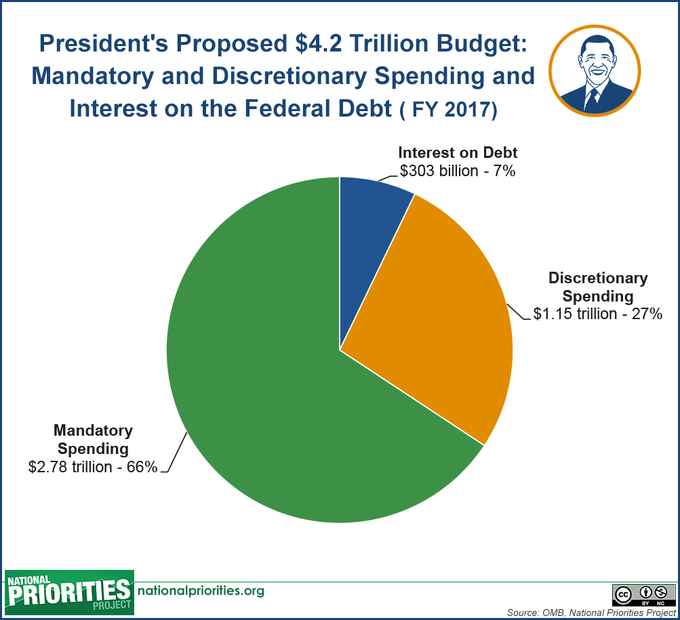This defines the MORAL BANKRUPTCY OF A NATION!
An Examination of Wasteful American Military Spending
In light of Trump's exorbitant defense budget proposal, here's a look at the many ways the military has recently wasted taxpayer dollars.
As you’ve probably heard, Donald Trump’s proposed military budget will boost US military spending by $54 billion. With a budget of $610 billion, the US military is already more expensive than the next seven countries combined. If you don’t count those countries, we spend more on our military than the rest of the world combined. The unneeded boost would make the US military industrial complex even larger, and Trump also plans to kill the National Endowment for the Arts and other cultural and humanities-related government groups. For comparison, the NEA has a budget of $148 million, only 0.012% of federal discretionary spending.
But on top of the exorbitant cost of the proposed military budget, there is a ton of waste baked into these hundreds of billions. The Pentagon’s own estimates state that a bureaucratic realignment alone could save $125 billion over five years. Here are some other incredible, ridiculous, and tragic ways that the military wastes taxpayer dollars.
Wishlists
Nowhere in the federal budget process is our absurd deference to the military more evident than with the wishlists built into the federal defense budgeting system.The Defense Department weighs its priorities when budgeting, but then the various branches can add additional "wishlist items" to the budget. If allocated, the wish list money comes directly out of the Treasury. So, even after the DoD has provided their already generous spending models, the actual defense budget can still balloon more as lobbyists go to the individual branches directly.
The F-35
One example of a wishlist purchase was 2016's earmark for $1.33 billion in spendingon eleven F-35 aircrafts. These weapons are known for their budget overruns and chronic system problems. The F-35 is the definition of throwing good money after bad. By 2013, the US had already spent $400 billion on a the plane that couldn't fly at night or in bad weather. Today, the all-in cost of the F-35 project is estimated to be in the trillions of dollars.
Bonus Submarines
Last year's budget also included a $90 billion dollar submarine spending fund that doesn't count against the naval budget. This fund was created because the cost of these new submarines is so massive that it would disrupt the resources allocated tobuild pretty much any other ships if it were in the actual defense budget. The so-called "National Sea-Based Deterrence Fund" comes directly from the Treasury. Some defense experts are even against these special funds, as they complicate that goalsof the actual defense budget. For example, the fund allows for the purchase of more materials to build submarines before the Defense Department has actually approved building them. As one budget watchdog put it, “Shipbuilders, and their friends in Congress, want to reduce the likelihood that any future President, Navy leader or Congress can cut the purchase of the next generation of ballistic missile submarines.”
Wasteful Bases
It is incredibly difficult to convince Congress to close a military base, no matter how unnecessary it may be. The bases are an incredibly visible piece of the local economy, and politicians eyeing reelection know this. Towards the end of Obama's presidency, he asked for a review of bases that could save $2 billion a year. Congress wouldn’t even allow for a review to be conducted. The problem has gotten so bad that the US military has threatened to act if Congress won't. The Pentagon estimates that 22 percent of US military installations are unnecessary for today's forces. If Congress refuses to launch a new BRAC (Base Realignment and Closure) Commission, the military may do it themselves.
The Littoral Combat Ship
Recently, the US shifted the bulk of its fleet to the Pacific Ocean. The Littoral Combat Ship was supposed to play a key role in this shift. The $30 billion program has been one headache after another. Computer failures, generator meltdowns, and even structural cracks are just a few of the program’s many failures. Even if these persistent problems could be solved, naval officers don't think LCS ships will do well in combat. So far, they have been proven right. Of the six active LCS ships, four suffered major breakdowns last year; at least one of these breakdowns occurred on the ship’s maiden voyage. The failure of LCS is so massive that the Navy has ordered a complete overhaul of the program, including retraining engineers involved. Of course, this will require investing even more money in the program. Even when the military admits they were wrong, they are rewarded with more funding.
Guantanamo Bay
The albatross that hung around Obama's neck throughout his time in office continues to plague the defense budget even after he's gone. The cost of keeping Guantanamo Bay open when Obama left office was $454 million a year: $11 million per inmate. Trump has promised to expand Guantanamo, though the base remains a blight on America's reputation abroad and a heinously ineffective expense. This expansion comes despite the ACLU’s analysis that Gitmo has generated over $5 billion in waste.
https://www.merryjane.com/culture/a-look-at-some-of-the-us-militarys-most-wasteful-spending-trump-defense-budget-bs

No comments:
Post a Comment